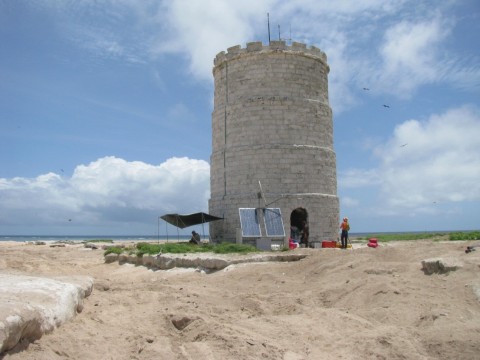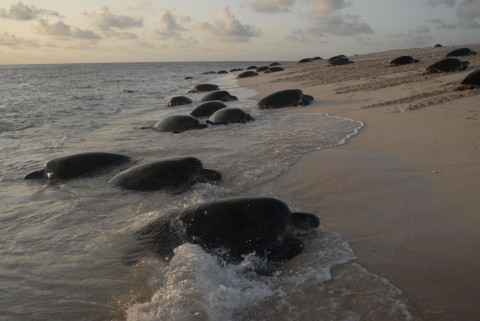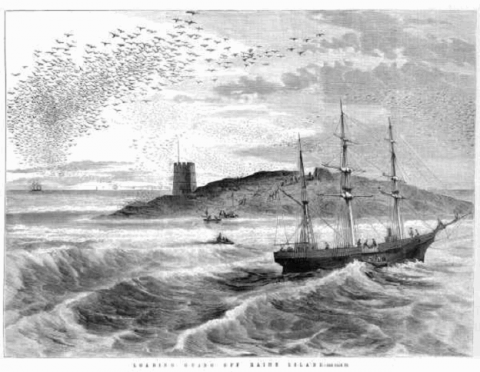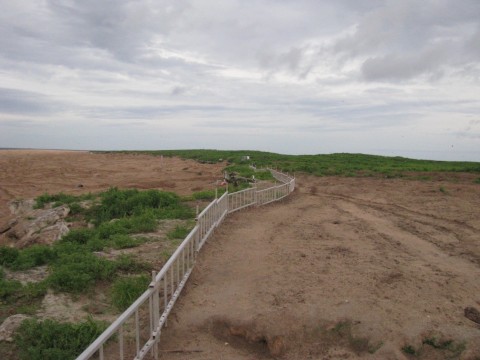Natural history and research and management of Raine Island’s green turtle rookery.
An amazing wildlife show and a critical bottleneck to future security of Torres Strait and northern Great Barrier Reef green turtle populations
Raine Island, a 27.5 hectare cay situated on a detached reef and located in the far northern Great Barrier Reef is, along with the adjacent Moulter Cay, the focus of approximately 90% of all nesting effort of the Northern Great Barrier Reef (NGBR) green turtle genetic stock (Limpus 2008).
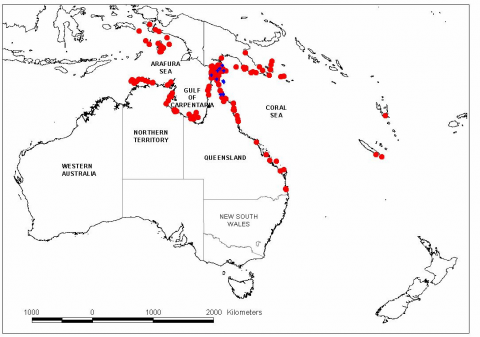
This population is considered the largest left in the world (Raine Island Management Statement, QLD Government 2006) and ranges widely through the tropical waters of north-eastern Australia, the Torres Straits, Papua New Guinea and Indonesia and continues to be culturally and nutritionally significant to the people of the area. Recent monitoring and research at the island indicates that successful incubation rates of green turtle nests is well below what might be expected for this location (QPWS internal report 2013). This is believed to be leading to low recruitment back to inshore feeding areas and combined with other pressures on the population may see numbers plummet in the coming decades (Limpus 2008, Limpus et. al. 2003). Management actions are underway in an attempt to solve some of these problems.
This the first section of "Raine Island" eatlas book, written by Neil Mattocks from Queensland National Parks and Wildlife Service. To read on, see the links at the bottom of the page.
Introduction
Raine Island on the northern Great Barrier Reef is identified as the largest rookery in the world for the green turtle (Chelonia mydas) with upwards of 15 000 females having been recorded attempting to nest at the one time along the approximately 1.8km of beach (Limpus 2008). The island is considered an iconic site within the Great Barrier Reef World Heritage Area, and not only for this large green turtle nesting population but also for its importance as a nesting and roosting site for approximately 16 species of seabird (Batianoff and Cornelius 2004). It also has important indigenous and cultural heritage values including the oldest existing colonial stone building in Queensland, a stone tower once used as a navigation beacon (Raine Island National Park (Scientific) Management Statement 2006-2012).
The island's incredible levels of productivity are evident the moment you step ashore. Senses are assailed by the noise, the heat and most overwhelmingly the smell. In 35 - 40 degree tropical heat sea bird guano, rotting turtle eggs and bloated adult green turtles that didn't make it back to sea after nesting give off powerful odours. The thousands upon thousands of seabirds greet you with a cacophony of calls and the unwary visitor can be splattered with steaming acidic waste from the sky. The beach in the turtle nesting season is a bulldozed mess littered with turtle bones, scattered eggs and freshly dead turtles that have tumbled onto their backs from low phosphate cliffs at the back of the beach.
Tiger sharks cruise so close to shore during the turtle nesting season their backs emerge from the water and they feast on exhausted females lacking the energy to escape when they return to the sea. At night ghost crabs and Night Herons patrol the foreshore and back-beach in search of hatchlings as they emerge from nests.
This incredible display of life easily leads the casual observer to believe that this is one of the great sea turtle rookeries of the world producing masses of offspring for future generations. However through ongoing research and monitoring it is becoming apparent that this may not be the case and that in fact Raine Island may be destroying rather than creating future turtle populations.
Raine Island - the biggest green turtle rookery left in the world
Marine turtles have been around for more than 120 million years reaching back to the late Triassic period and the time of the dinosaurs. The modern day species Chelonia mydas, the green turtle, has evolved into a highly successful seagrass grazer with enormous 'herds' of 'tens of thousands' existing right up into recorded history. It was said that mariners could be sure they were heading in the right direction if the bumps on the hull of their vessels from migrating turtles remained consistent (Jackson 1997).
However these populations have declined alarmingly over the past several hundred years (Jackson, 1997) making sites like Raine Island all the more important with every passing year and its role as a potential producer of 100's of thousands maybe over a million hatchlings in a year can hardly be overstated. This population, the northern Great Barrier Reef genetic stock, has somehow 'decided' that it is best that they focus all their effort at this one small cay (along with nearby Moulter Cay) rather than spread more widely across the region. Just why it has become a focus of such heavy nesting activity remains a mystery. Its position at a northern entrance to the reef (with water dropping off precipitously to over 350m just off the island edge may play a part.
It is estimated that Raine Island has been a significant turtle rookery for at least 1100 years (Limpus 2008). Despite recent concerns that the island may be losing sand, and that this may be part of the problem with incubating eggs, it appears that the island has actually accumulated approximately 68 000m³ of sand over the past 40 years (Dawson and Smithers 2010). The island is subject to the prevailing south-east trade-winds (April – October) and occasional cyclonic conditions during the monsoon season (November – March) resulting in seasonal shifts in beach sand profiles.
Every year from late October to February egg laden females having migrated from many parts of northern Australia, eastern Indonesia, Papua New Guinea and as far away as Vanuatu and New Caledonia (a migration of over 2700km) crawl up the beach at night and attempt to lay their approximately 100 eggs. They are generally expected do this 4-6 times in a nesting season and then not return again for the next two to six years depending in large part on how well they have been able to build up fat reserves back at seagrass feeding grounds. Cyclones, El Nino/La Nina weather patterns and coastal water quality all impact on seagrass quality and therefore how often green turtles reproduce (Limpus 2000, Limpus 2008).
Once successfully laid, clutches of eggs generally take around 60 days to incubate before the hatchlings, as a group, emerge from the sand and scurry down the beach to the sea where they have to dodge crabs, birds and fish before they can make it over the reef flat and into the relative safety of deeper water.
The island and its turtles, although perhaps accessed fairly regularly by maritime Aboriginal and Torres Strait Islander groups (Raine Island Management Statement, QLD Government 2006) were probably relatively untouched until the mid-nineteenth century. Impacts to the nesting turtle and seabird populations have been far greater from European use of the island, first as the site of a navigation beacon constructed in 1844 from phosphate rock cut from the island and then as a guano mine (1890 to 1892). Accounts from this period describe sailors arriving at the island and crushing all the seabird eggs they can see so they would know that anything they collected in the coming days would be fresh (Stoddart et. al. 1981). Turtles were also an important food source at this time.
In late 1958 a sea turtle harvesting business was set up by the Whittakers from Cairns (Limpus et. al. 2003). This was following a change to the Queensland Fisheries Act that meant turtles could be harvested without restriction north of 15º in Queensland. During the 1958-59 nesting season at Raine Island approximately 1200 turtles were collected, butchered and offered for sale through Cairns. The harvest did not continue beyond this one season as it was not profitable with only small volumes of the meat sold (Limpus et. al. 2003).
By 1973 the Queensland government's interest in the island had shifted significantly from a source of income to one of conservation and the first systematic study of the rookery occurred in the 1974/75 nesting season. Within a few years data was showing that this was a site of major international importance for a number of species and in particular exceeded in size other green turtle rookeries such as Tortuguero made famous by Dr Archie Carr in his book 'So Excellent a Fishe'. By 1981 when the Great Barrier Reef was declared a World Heritage Area Raine Island was specifically mentioned under Criterion (X) for its 'outstanding universal value' from the point of view of science and conservation - see https://whc.unesco.org/en/list/154
In total the island has approximately 50 000m² of nesting beach with a central depression that during the wet season is well vegetated by shrubs and grasses (there are no trees on the island) and populated by thousands of nesting seabirds with 16 breeding populations including masked and brown boobies, lesser frigatebirds, red-tailed tropicbirds and the endangered herald petrel. This seabird nesting area is largely protected from wandering sea turtles by a low (approximately 1 - 1.5M) phosphate rock cliff formed by phosphates leaching from avian guano cementing sediments together (Dawson and Smithers 2010). The sand of the island is made up primarily of Foraminifera tests (43%), mollusc fragments (25%) and coralline algae and fine coral rubble (21%) with this supply being generated from the 210 hectare reef flat to the south-east of the cay (Dawson and Smithers 2010).
Foram based sand binds poorly and dries quickly. Not a good combination if you are a turtle trying to dig a 50cm deep egg-chamber with your hind flippers in the dark, out of your natural watery home, and while constantly being jostled by fellow females. Rates of nesting failure are high, particularly when the sand is dry and females expend enormous amount of energy just trying to get their eggs safely into a nest and covered. These eggs then have to survive approximately 8-9 weeks in the sand and not get dug up by another female and not succumb to other identified risks (discussed below).
The island is spectacular, of that there is no doubt, but it is also at significant risk. Sea level rise and climate change is predicted to have an increasing impact on these low-lying cays (Fuentes et. al. 2010) and there is already concern that seabird nesting numbers are suffering from irregular fish supplies at their off-shore feeding areas (Congdon et. al. 2007). In particular there is clearly something wrong with green turtle hatchling production (QPWS Internal Report 2013).
There is real concern that Raine Island's future as a centrepiece of the Great Barrier Reef's World Heritage listing is in doubt. Major management actions are now underway in an attempt to tackle this and they are discussed in Part Two.
A summation of the biology of the turtles of the island and its human use can be found at https://parks.des.qld.gov.au/parks/raine-island
Management concerns and actions
Sea turtles, given their reproductive strategies (laying eggs on low-lying beaches), have been highlighted as particularly vulnerable to predicted sea level rise and different climate regimes (Fuentes et. al. 2010). The 'Great Barrier Reef Climate Change Action Plan 2007-2012' - see for example https://www.nccarf.edu.au/localgov/case-study/great-barrier-reef-climate-change-action-plan-2007-2012 developed principally by the Great Barrier Reef Marine Park Authority was the catalyst from which the identified environmental risks at the island and potential management actions were assessed for risk and developed into a plan of action. This project now titled the 'Raine Island Recovery Project' is a partnership between the Commonwealth GBRMPA, Queensland Parks and Wildlife Service and Department of Environment and Heritage Protection, the Traditional Owners and other stakeholder groups. The project is now actively seeking commercial business partners to help fund the project and, along with other stakeholders, continue research, monitoring and management actions with the objective of achieving significantly improved outcomes for this rookery. Further information on this project can be found at https://www.ehp.qld.gov.au/wildlife/animals-az/green-turtles-raine-island.html
Dr Colin Limpus and fellow researchers with the Queensland Parks and Wildlife Service (QPWS) (2003) first observed that green turtle hatchling numbers did not seem to be at expected levels after the 1996-97 nesting season. High densities of adult females had lead researchers to expect tens of thousands of hatchlings entering the water at night during a return trip in February 1997 which included a film crew set to record the event. When only sporadic small numbers of hatchlings were encountered it was clear that there had been significant reproductive failure, at least within that season. Follow up monitoring and research over the next decade, which has intensified since 2010 indicates that low incubation success is occurring every year and that there may be multiple environmental factors leading to this (see for example at https://www.ehp.qld.gov.au/wildlife/animals-az/green-turtles-raine-island.html).
Understanding what is happening has taken time, and a significant part of this has been because of the island's isolation at over 600km by vessel from the nearest State management base in Cairns. Field trips have typically been undertaken in December for the peak nesting season but follow up trips in February/March, during what should be peak hatchling emergence, have been infrequent due to a combination of logistical difficulties (peak period of the cyclone season, insufficient funding) and other marine park monitoring and management priorities.
One of the early difficulties for this project was gathering more data on actual levels of hatchling production. At that time (2010) evidence supporting concerns about production was mainly limited to analysis of clutches that had emerged because they could be identified by hatchling tracks leading from them. This, while supporting anecdotal evidence about low production was time consuming and selective in its analysis. Techniques were developed to count hatchlings as they emerged from multiple nests along the beach (50m sand trenches were dug and hatchlings temporarily trapped and counted) and nests were marked at the point of lay using a Differential Global Positioning Systems (DGPS) and could then be relocated on subsequent trips with only a 40mm error. Data collected between 2010/2014 on incubation success has verified the alarmingly low rates of production (QPWS Internal Report 2013). In February and March 2014 approximately 2500 hatchlings were estimated to have emerged from the island when up to 370 000 could have been expected, taking into account the numbers of nesting turtles and their relative success in laying 8 weeks earlier, (Pers. Comm. Dr Andy Dunstan, DEHP).
Significant efforts have been made to survey the island's topography. Data from water level sensors (measuring tidal inundation of the nesting beach) and visual observations during Spring Tides all support the theory that large areas of the beach become flooded during large tides and storm events. Developing embryos can only withstand these conditions for a limited period before mortality rates climb. Investigation of nests mapped by DGPS and then excavated after the due hatching date confirm the low hatching success of eggs with most embryos dying in the early stages of development. During the high density nesting season of 2013/2014 around 50% of nests/eggs were also destroyed by nesting turtles further reducing hatchling production. Hatchling success was around 10% as compared with upwards of 90% in comparable green turtle rookeries (Pers. Comm. Dr Andy Dunstan, DEHP).
While inundation appears to be a major factor it does not fully explain hatching failure. During a high density season huge amounts of sand are moved by turtles and this can result in sand ramps being formed against the interior cliff allowing nesting turtle access to the higher level interior. This area is well above inundation height and hatching success (2013/2014) of nests was significantly higher, at more than 50%. However similar embryo mortality patterns were still observed, just at a lower level. Within the beach area inundation did not fully explain survival or demise of nests. Recent laboratory incubation experiments also suggest that developing embryos may in fact be able to survive longer periods of inundation (in water-logged sand) than previously thought (pers. comm. Dr Andy Dunstan, DEHP).
It may be that a secondary effect such as a microbial pathogens, toxins or 'microbial oxygen debt' is having a compounding impact. This has been documented at large Costa Rican Olive Ridley sea turtle rookeries (Valverde et. al. 2010). This is now being investigated by researchers at the Queensland Department of Environment and Heritage Protection and James Cook University with on-site and laboratory studies proposed as a major element of the 2014-15 seasons work.
A further impact on overall hatchling production is also evident. The sand on the island is made up largely of coral fragments (55%) and foraminifera tests (45%) and when dry it binds very poorly. Combine this with a high density of turtles all trying to dig nests at the same time and the result is chaos. Under these circumstances very few females are able to successfully dig a nest and lay eggs on a particular night and after repeated failures over a number of days they may jettison eggs in the sea and begin to reabsorb egg follicles to fuel their own ongoing energy needs. Around 60,000 female turtles were recorded at Raine Island during the 2013-14 season. In perfect conditions this would mean individuals nesting successfully an average of 6 times, once every 12 nights, resulting in 5000 turtles nesting per night. In reality in late November 40,000 turtles were trying to nest with almost 0% success per night. This occurred most probably due to an initial 'bottleneck' arrival of nesting turtles combined with extremely dry sand conditions. A few days later rainfall that bound the sand together made digging a nest much easier for the females. Nesting success increased to a still very low 20% with around 20,000 turtles ashore per night. So turtles prepared to lay around 6 nests in a season, may just not be laying as many nests as they were capable of when they arrived at the island.
Hatchlings will emerge from those eggs that are successfully laid and incubated in the sands of the island after approximately 60 days. However their troubles are not over then with a number of bird species in particular Nankeen Night Herons (Nycticorax caledonicus) taking significant (but as yet unquantified numbers) of hatchlings and then reef fish and shark species targeting them as they cross the reef flats at night. While this can all be considered as natural predation, when it is coupled with the problems identified around adults successfully producing hatchlings in the first place it means that the number of hatchlings reaching the pelagic phase of their life-cycle may be far below what is required to sustain the population.
There are also significant risks to the adult turtles from the small (1 - 2m) phosphate cliffs that ring much of the guano caked centre of the island where most of the seabirds are found. Nesting turtles are able to find their way up onto these cliffs through a number of sand ramps around the island and then tumble off, landing upside down from which there is no escape. It has been estimated (Limpus et. al. 2006) that perhaps up to 1500 adult females turtles die in this way in one season, along with others that become disorientated on low lying back beach areas during the heat of the day.
Management Actions - to date
Fence construction
One of the first direct management actions focussed on fencing off some of the main areas where adult turtles were accessing the central parts of the island. Not only were they tumbling off the small cliffs to their eventual death but also significantly disturbing nesting attempts by seabirds in the central parts of the island. These fences over the past 3 years have proven very effective in reducing the number of deaths of adult turtles. It is estimated that 500 (plus) females were saved during last season by fencing efforts (Pers. Comm. Dr Andy Dunstan, DEHP).
Trials of sand movements
One of the key ideas that have been considered over the past several years has been re-nourishing the island with imported sand. The thinking is that if incubating embryos are drowning during large tides then raising the height of the sand will significantly improve their chances of survival. It may also solve problems where turtle have been identified trying to dig nests in areas of shallow sand overlaying beach-rock. It has been estimated that approximately 50 000m³ of sand may be enough to adequately cover nesting areas.
There are risks involved in a project like this at an iconic, World Heritage Listed, National Park (Special Management Area) Scientific, surrounded by a Commonwealth Marine Park Special Management Area and co-managed under an Indigenous Land Use Agreement with the Wuthathi People, Erubam Le, Meriam Le and Ugarem Le Native Title holders. And on top of all this it is one of the most photographed and filmed sites on the Great Barrier Reef with even legendary natural history documentary maker Sir David Attenborough having filmed there in 1956 and possibly again late in 2014.
There are concerns that there would be impacts on the seabirds, the sand may not be stable or have some other unpredicted impacts on the island. However there is also a sense that an adaptively managed project may have minimal risk of negative impacts and may result in significant improved hatchling production. Some trials have been undertaken using sand on the island to increase depths in some levels; one season of data has proved to be inconclusive in its effect. There is also the issue of dry sand causing nesting failure; perhaps a different type of sand that binds better might achieve better results but this may have real environmental impacts? Larger scale trials, not introducing new sand but rather re-profiling areas of the existing beach are planned for 2014-2015.
It is evident that management agencies are faced with a relatively complex set of conditions at an isolated location and while headway has been made over the past four years there is much more to be done. A 'Prospectus' was recently released by the Queensland Government seeking a major sponsor for the project and a short 'You Tube' video narrated by Sir David Attenborough highlights the issues and asks for help. These can all be found at https://www.ehp.qld.gov.au/wildlife/animals-az/green-turtles-raine-island.html
The future for Raine Island's turtles
One of the key questions raised by the ongoing work at Raine Island is how much should humans interfere with 'natural' systems? These types of questions along with others around themes like eco-engineering, re-wilding and assisted migration are becoming more common (e.g. Marris 2011). Older management approaches of focussing on protecting the 'status quo' (some specific state identified as the bench-mark) and trying to keep out feral plants and animals, minimise human impacts and maintain current bio-diversity may no longer be as valid in the 21st Century. We are going to have to re-think how we approach protecting our environments and species because by any reasonable measure the human footprint continues to get heavier.
Perhaps the work at Raine Island will be an early and successful model of management for the Great Barrier Reef that uses intervention actions funded by multiple sources, driven by many stakeholders and coordinated by a State/Commonwealth Government partnership. If so the outcome will be a positive boost to an iconic species that continues to play such an important role in the lives of people and ecosystems throughout northern Australia, the Torres Straits and right around the tropical world.
References
Batianoff, GN, Cornelius, N.J. (2004). Tropical seabirds of Raine Island: breeding ecology, population trends and habitat. Unpubl. Rept. to RIC. 64pp.
Congdon, B.C., Erwin, C.A., Peck, D.R., Baker, G.B., Double, M.C. and O'Neill, P. 2007. 'Vulnerability of seabirds on the Great Barrier Reef to climate change'. In Johnson, J.E. and Marshall, P.A. (eds), Climate Change and the Great Barrier Reef :A Vulnerability Assessment, 427-463.
Fuentes MMPB, Maynard JA, Guinea M, Bell IP, Werdell PJ, Hamann M (2009) Proxy indicators of sand temperature help project impacts of global warming on sea turtles in northern Australia. Endangered Species Research Vol. 9: 33-40.
Fuentes MMPB, Limpus CJ, Hamann M, Dawson J (2009) Potential impacts of projected sea-level rise on sea turtle rookeries. Aquatic Conservation: Marine and Freshwater Ecosystems (2009)
Fuentes MMPB, Dawson JL, Smithers SG, Hamann M, Limpus CJ (2010) Sedimentological characteristics of key sea turtle rookeries: potential implications under projected climate change. Marine and Freshwater Research 61: 464-473.
Jackson JBC (1997) Reefs since Columbus. Coral Reefs 16, Suppl: S23-S32.
Limpus CJ, Miller JD, Parmenter JD, Limpus DJ (2003) The green turtle Chelonia mydas, population of Raine Island and the northern Great Barrier Reef: 1843-2001. Memoirs of the Queensland Musum 49 (1): 349-440.
Limpus CJ, Limpus DJ, Munchow M, Barnes P (2005) Queensland turtle conservation project: Raine Island turtle study, 2004-2005. Internal unpublished report (Conservation and technical data report Volume 2005, Number 4) Queensland Government (Environmental Protection Agency) Brisbane.
Limpus CJ (2008) A biological review of Australian Marine Turtles 2. Green Turtle, Chelonia mydas (Linnaeus). September 2008. Queensland Environmental Protection Agency, Queensland Government, Brisbane.
Limpus, C.J., Limpus, D. J., Munchow, M., Barnes, P. (2006). Queensland Turtle Conservation Project, Raine Island Study 2004-2005. The State of Queensland. Environmental Protection Agency.
Limpus CJ, Miller JD, Parmenter EJ, Limpus DJ (2003).The green turtle, Chelonia mydas, population of Raine Island and the northern GBR : 1843-2001. Mem. Qld. Museum, 49 (1) 349-440.
Limpus CJ, Nicholls N (2000) ENSO Regulation of Indo-Pacific Green Turtle Populations. Applications of Seasonal Climate Forecasting in Agricultural and Natural Ecosystems, Atmospheric and Oceanographic Sciences Library Volume 21, 2000, pp 399 – 408.
Marris E. (2011). Rambunctious Garden: Saving Nature in a Post-Wild World. Bloomsbury USA, New York.
Queensland Government, Queensland Parks and Wildlife Service 2006, Raine Island National Park (Scientific) Management Statement 2006 - 2016. Regional Policy – Approved 19 December 2006.
Queensland Government, Queensland Department of Environment and Heritage Protection, 'Raine Island and Moulter Cay Chelonia mydas hatching success assessment 9th – 14th February 2013' (DRAFT) March 2013
Valverde RA, Wingard S, Gómez F, Tordoir MT, Orrego CM (2010) Field lethal incubation temperature of olive ridley sea turtle Lepidochelys olivacea embryos at a mass nesting rookery. Endangered Species Research Vol. 12:77-86.





